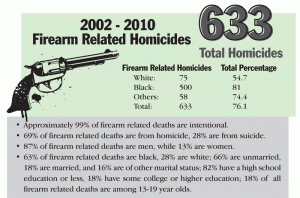By LESLIE COLLINS
Northeast News
May 1, 2013
While Kansas City’s homicide rate has trended downward since the 1990s, firearm related homicides have remained steady.
From 2002 to 2012, 76 percent of Kansas City’s homicides were associated with a gun, said Dr. Rex Archer, director of health for the city of Kansas City.
Archer discussed the findings of a new health department report during a recent city Public Safety and Emergency Services Committee meeting.
More than half of Kansas City’s homicides are retaliation homicides and some homicides result from an undiagnosed mental illness, he said.
“Sometimes the general public thinks the folks that are crazy are the ones that are causing some of these homicides,” Archer said. “Sometimes when the public talks about the term crazy, they’re talking about what we as physicians call Schizophrenia – people who have a variety of psychotic delusions and isssues. It’s actually not the case.”
Those with mental illnesses like Schizophrenia aren’t more likely than the general population to commit a homicide, he said. However, undiagnosed or not properly treated depression can lead to homicide.
“Not only are there suicides from that lack of treatment, sometimes they become combination homicide/suicides,” Archer said.
One finding Archer called “troublesome” is Children’s Mercy Hospital has seen its caseload of unintentional firearm injuries double, which most likely means firearms aren’t being properly secured and safely stored, he said. Earlier this month, a 12-year-old boy in Kansas City accidentally shot and killed his 14-year-old brother. The 12-year-old has now been charged with first-degree involuntary manslaughter, a Class C felony.
In 2002 the number of emergency room visits due to unintentional firearm related injuries was 9.7 per 100,000 population. By 2010, that number was 19.5.
Also alarming is that 57 percent of Kansas City’s homicides are occurring in zip codes 64110, 64127, 64128, 64130, 64131, 64132 and 64134.
“If our homicide rate was homogenous throughout the city or the metro area, in my opinion, there would have been much more outrage about it a long time ago,” Public Safety Chair John Sharp said.
Public Safety Committee member Jermaine Reed stressed it’s important to look past the statistics and remember these are individuals. Archer agreed.
“It is important to remember they are individuals,” Archer said. “When I was 20, my brother was shot and killed, and we’ve lost two health department staff in the last two years from homicides, so we feel this very much.”
“Over 100 homicides every year (in Kansas City) is not acceptable,” Reed said. “And the people’s lives who are taken senselessly is not acceptable.”
Sharp said while Washington, D.C., is considered a violent city, it was able to drop its homicide rate to 88 homicides in 2012.
“They have done a tremendous turnaround,” Sharp said, adding that hearing from Washington, D.C., officials during a future meeting could be beneficial.
“We clearly have a long way to go and this is an issue that is vital to all of us,” Sharp said.




















